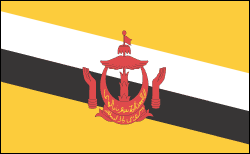BRUNEI DARUSSALAM

Geography: About the size of Delaware, Brunei is an independent sultanate on the northwest coast of the island of Borneo in the South China Sea, wedged between the Malaysian states of Sabah and Sarawak.
Government: Constitutional sultanate.
History: Brunei was trading with China during the 6th century, and, through allegiance to the Javanese Majapahit kingdom (13th to 15th century), it came under Hindu influence. In the early 15th century, with the decline of the Majapahit kingdom and widespread conversion to Islam, Brunei became an independent sultanate. It was a powerful state from the 16th to the 19th century, ruling over the northern part of Borneo and adjacent island chains. But Brunei fell into decay and lost Sarawak in 1841, becoming a British protectorate in 1888 and a British dependency in 1905. Japan occupied Brunei during World War II; it was liberated by Australia in 1945.
The sultan regained control over internal affairs in 1959, but Britain retained responsibility for the state's defense and foreign affairs until 1984, when the sultanate became fully independent. Sultan Bolkiah was crowned in 1967 at the age of 22, succeeding his father, Sir Omar Ali Saifuddin, who had abdicated. During his reign, exploitation of the rich Seria oilfield had made the sultanate wealthy. Brunei has one of the highest per capita incomes in Asia, and the sultan is believed to be one of the richest men in the world. In Aug. 1998, Oxford-educated Prince Al-Muhtadee Billah was inaugurated as heir to the 500-year-old monarchy.
Government: Constitutional sultanate.
History: Brunei was trading with China during the 6th century, and, through allegiance to the Javanese Majapahit kingdom (13th to 15th century), it came under Hindu influence. In the early 15th century, with the decline of the Majapahit kingdom and widespread conversion to Islam, Brunei became an independent sultanate. It was a powerful state from the 16th to the 19th century, ruling over the northern part of Borneo and adjacent island chains. But Brunei fell into decay and lost Sarawak in 1841, becoming a British protectorate in 1888 and a British dependency in 1905. Japan occupied Brunei during World War II; it was liberated by Australia in 1945.
The sultan regained control over internal affairs in 1959, but Britain retained responsibility for the state's defense and foreign affairs until 1984, when the sultanate became fully independent. Sultan Bolkiah was crowned in 1967 at the age of 22, succeeding his father, Sir Omar Ali Saifuddin, who had abdicated. During his reign, exploitation of the rich Seria oilfield had made the sultanate wealthy. Brunei has one of the highest per capita incomes in Asia, and the sultan is believed to be one of the richest men in the world. In Aug. 1998, Oxford-educated Prince Al-Muhtadee Billah was inaugurated as heir to the 500-year-old monarchy.

Map of Brunei
Sultan: Haji Hassanal Bolkiah
(1967)
Land area: 2,035 sq mi (5,271 sq km);
total area: 2,228 sq mi (5,770 sq km)
Population (2012 est.): 395,027 (growth
rate: 1.7%); birth rate: 18/1000; infant mortality rate:
11.8/1000; life expectancy: 75.9; density per sq km: 72
Population (2012 est.): 408,786 (growth
rate: 1.69%); birth rate: 17.74/1000; infant mortality rate:
11.15/1000; life expectancy: 76.37; density per sq km: 72
Capital and largest city (2009 est.):
Bandar Seri Begawan, 78,000
Other large cities: Kuala Belait
27,800, Seria 23,400
Monetary unit: Brunei dollar
National Name: Negara Brunei
Darussalam
Languages:
Malay (official), English, Chinese
Ethnicity/race:
Malay 67%, Chinese 15%, indigenous 6%, other
12%
National Holiday:
National Day, February 23
Religions:
Islam (official religion) 67%, Buddhist 13%,
Christian 10%, indigenous beliefs and other 10%
Literacy rate: 92.7% (2011 est.)
Economic summary: GDP/PPP (2011
est.): $21.11 billion billion; per capita $38,500. Real growth
rate: –2.8%. Inflation: 2%. Unemployment: 2.7%
(2011). Arable land: 1%. Agriculture: rice,
vegetables, fruits; chickens, water buffalo, eggs. Labor
force: 198,800; note: includes foreign workers and military
personnel; temporary residents make up about 40% of labor force;
agriculture, forestry, and fishing 2.9%, production of oil, natural
gas, services, and construction 61.1%, government 36% (2003
est.). Industries: petroleum, petroleum refining, liquefied
natural gas, construction. Natural resources: petroleum,
natural gas, timber. Exports: $10.67 billion f.o.b. (2011
est.): crude oil, natural gas, refined products. Imports:
$228.4 billion c.i.f. (2011 est.): machinery and transport
equipment, manufactured goods, food, chemicals. Major trading
partners: Japan, South Korea, Australia, U.S., Thailand,
Indonesia, China, Singapore, Malaysia, UK (2004).
Communications: Telephones: main lines
in use: 79,900 (2011); mobile cellular: 435,100 (2011). Radio
broadcast stations: AM 3, FM 10, shortwave 0 (1998).
Television broadcast stations: 2 (1997). Internet
hosts: 49,403 (2011). Internet users: 314,900 (2011).
Transportation: Highways: total:
2,971 km (2011). Waterways:
209 km; navigable by craft drawing less than 1.2 m (2004). Ports
and harbors: Lumut, Muara, Seria. Airports: 2 (2011
est.).
International disputes: in 2003 Brunei
and Malaysia ceased gas and oil exploration in their disputed
offshore and deepwater seabeds and negotiations have stalemated
prompting consideration of international legal adjudication;
Malaysia's land boundary with Brunei around Limbang is in dispute;
Brunei established an exclusive economic fishing zone encompassing
Louisa Reef in southern Spratly Islands in 1984 but makes no public
territorial claim to the offshore reefs; the 2002 "Declaration on
the Conduct of Parties in the South China Sea" has eased tensions in
the Spratly Islands but falls short of a legally binding "code of
conduct" desired by several of the disputants.
-------------------- o --------------------
No comments:
Post a Comment